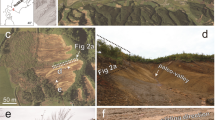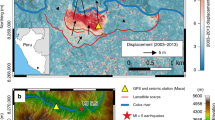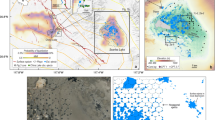Curious dry craters formed in the aftermath of a disastrous earthquake are explained.
Abstract
The Bhuj earthquake in January 2001, with a moment magnitude of 7.7, was one of the most disastrous in India's recorded history. Although its fault plane did not rupture the surface, the earthquake caused ground failure, including the formation of sand-blow craters and sand fissures, indicative of liquefaction of subsurface sediment, over an area of about 15,000 square kilometres1. Here we investigate the two large, dry craters that formed during the earthquake, and estimate the likely subsurface pressure at the time from a trajectory analysis of the ejected clasts. We conclude that the craters were created by explosive deformation of the ground that probably resulted from the delayed effects of soil liquefaction.
Similar content being viewed by others
Main
Liquefaction is a result of the cyclic loading of the ground by intense shear waves during a severe earthquake, leading to an increase in pore-water pressure and a reduction in the strength of water-saturated sediments2,3. At a liquefaction site near the town of Umedpur, about 48 km west–northwest of the earthquake's epicentre (Fig. 1a), two remarkable dry craters (2.4 × 1.8 m and 1.6 × 1.5 m) formed, as well as several large sand-blow craters and sand fissures (Fig. 1b). The field of clasts ejected from the dry craters suggests that they were formed by an explosive ground failure. The development of craters has been attributed to large hydraulic gradients in buried clay layers4. Inspection revealed that vented sand and silt were already on the surface when these craters formed, as shown by the impact/splash features created by the ejected clasts (Fig. 1c).
a, Map of northwestern India showing the location of the earthquake's epicentre (star) and the Umedpur liquefaction site (triangle); inset, contour map showing the co-seismic volumetric strain (red, compression; blue, rarefaction). b, Photograph of a dry crater and the ejected clasts. c, Close-up of an ejected clast showing the deformation of the surrounding sediment as a result of the impact (pen is shown for scale). d, Trajectories for ejected clasts of different sizes. Maximum trajectory height is 6.5 m. From the size and distance of the thrown clasts, the explosive pressure can be estimated by using trajectory theory.
We estimated the subsurface pressure during the earthquake from an analysis of the calculated trajectories for clasts of different sizes. The impact distance of a thrown object with take-off angle θ and velocity ν is xmax = (2ν2sinθcosθ)/g, where g is the acceleration due to gravity. If the pressure during the explosion acts similarly on all clasts, the smaller, less massive clasts will attain a greater velocity and travel farther than the larger clasts (Fig. 1b, d). The velocity depends on the pressure, P, that provides the force to accelerate, a, the clasts. We assume that the pressure is constant for the duration, τ, of the ejection, which gives ν = aτ = Pτ/ρL, where ρ is the density and L is the size of a clast. Substituting ν in the distance formula gives a relation between clast size and impact distance of L2 = κ(Pτ)2(1/xmax), where the constant κ =(2sinθcosθ)/ρ2g.
A plot of L against 1/xmax will be a straight line with a slope related to Pτ. Although there is a considerable scatter in clast size and distance, a rough estimate is obtained by taking spatial-average measurements at several impact distances up to a maximum of 26 m. From the craters' geometry, we estimated the take-off angle, θ, as being about 45°.
From the slope of the straight-line fit to our data, we obtain an estimate for Pτ of 11 kPa s. Guided by villagers' accounts that a loud report was heard, we assume that the explosion occurred in about 0.2 s, giving a pressure of 56 kPa, or the equivalent of a 5.6-m column of water. This simple model ignores the dynamic interaction between gas pressure and the break-up and ejection of the clasts, and so probably represents an underestimate of the actual explosive pressure. Our result is consistent, however, with reports of water-fountain heights of 3–4 metres seen soon after the earthquake.
Crater formation at Umedpur occurred in two phases. As such, the dry craters, which formed after the large sand-blow craters and fissures, are remarkable examples of the delayed effects of liquefaction. The exact mechanism of formation cannot be conclusively determined, but several possible models could account for this delay. The difference in timing may be related to a variability in the subsurface stratigraphy and/or to liquefaction in more than one layer. Conditions may have been such that a relatively impermeable layer allowed the development of a pressure head that was ultimately released explosively, giving rise to the craters (deeper and thinner clay layers develop greater maximum hydraulic gradients4). Dry craters would be generated by the release of large bubbles of gas, perhaps as a result of aggregative fluidization2 or of the collapse of a gas-filled cavity at depth soon after liquefaction occurred, which would force gas to the surface.
The severity of ground failure as a result of liquefaction is related to site conditions, ground motions and distance from the epicentre5. In general, Bhuj's liquefaction features decrease in size with increasing epicentral distance. However, some of the largest features occur west of the fault rupture, possibly as a result of western directivity of seismic energy1,6. As-yet-unknown soil conditions and ground motions at the site are required to model the liquefaction potential, for which the subsurface pressure estimated here could prove a key parameter.
References
Tuttle, M. P. et al. Earthquake Spectra 18, 79–99 (2002).
Allen, J. R. L. Sedimentary Structures: Their Character and Physical Basis (Elsevier, Amsterdam, 1982).
Seed, H. B. & Idriss, I. M. Ground Motions and Soil Liquefaction During Earthquakes (Earthquake Eng. Res. Inst., Univ. California, Berkeley, 1982).
Elgamal, A.-W., Dobry, R. & Adalier, K. in Proc. 2nd US–Japan Workshop on Liquefaction, Large Ground Deformation and their Effects on Lifelines 233–245 (NCEER-89-0032, 1989).
Bartlett, S. F. & Youd, T. L. NCEER-92-0021 (Buffalo, NY, 1992).
Bendick, R. et al. Seism. Res. Lett. 72, 328–335 (2001).
Author information
Authors and Affiliations
Corresponding author
Ethics declarations
Competing interests
The authors declare no competing financial interests.
Rights and permissions
About this article
Cite this article
Rydelek, P., Tuttle, M. Explosive craters and soil liquefaction. Nature 427, 115–116 (2004). https://doi.org/10.1038/427115a
Issue Date:
DOI: https://doi.org/10.1038/427115a
This article is cited by
-
Estimating frequency-dependent shear wave velocity in near-surface sediment based on seismic interferometry
Earth, Planets and Space (2023)
-
Near-surface softening and healing in eastern Honshu associated with the 2011 magnitude-9 Tohoku-Oki Earthquake
Nature Communications (2021)
-
Initiation of the Lusi mudflow disaster
Nature Geoscience (2015)
-
Soft sediments and damage pattern: a few case studies from large Indian earthquakes vis-a-vis seismic risk evaluation
Natural Hazards (2014)
-
Geoseismological investigation of the January 26, 2001 Bhuj earthquake in western peninsular India
Natural Hazards (2013)
Comments
By submitting a comment you agree to abide by our Terms and Community Guidelines. If you find something abusive or that does not comply with our terms or guidelines please flag it as inappropriate.




